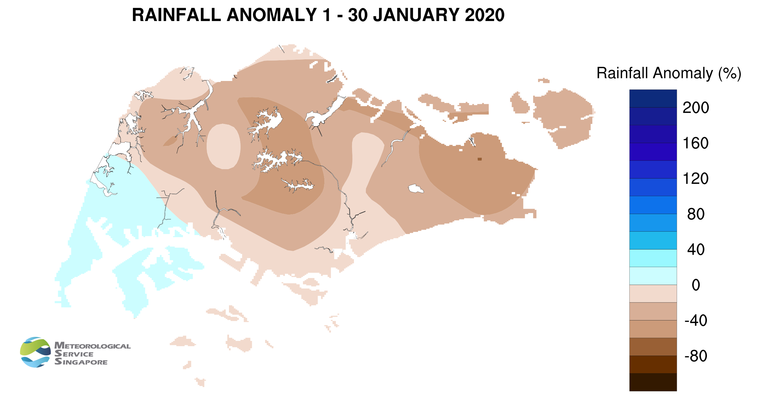Fortnightly Weather Outlook for 31 January – 15 February 2020
WEATHER OUTLOOK (31 January – 15 February 2020)
1 For the first fortnight of February 2020, the Meteorological Service Singapore (MSS) forecasts warm and occasionally windy conditions on most days. Afternoon thundery showers are also expected later in the fortnight. The prevailing Northeast Monsoon season will continue, with low-level winds blowing from the northwest or northeast.
2 In the first half of the fortnight, the monsoon rain band is forecast to be located south of the Equator, and rain cloud formation over Singapore and the surrounding vicinity is likely to be suppressed. This is expected to bring warm and occasionally windy conditions on most days during the period. With the migration of the monsoon rain band closer to the Equator in the latter half of the fortnight, enhanced thunderstorm cloud development can be expected over Singapore. This is forecast to bring short-duration moderate to heavy thundery showers mostly in the afternoon on some days. The showers on most of these days are expected over parts of the island, and could be widespread on one or two days. Overall, rainfall for the first fortnight of February 2020 is forecast to be below normal over most parts of Singapore.
3 With warm conditions forecast in the first fortnight of February 2020, the daily temperature on most days is expected to range between 24°C and 34°C.
4 For updates of the daily weather and haze situation, please visit the MSS website (https://www.weather.gov.sg), NEA website (www.nea.gov.sg), or download the myENV app, MSS’ Weather@SG app, and the haze microsite (www.haze.gov.sg).
REVIEW (1 – 30 January 2020)
5 Northeast Monsoon conditions prevailed over Singapore and the surrounding region in January 2020. On most days during the month, the low-level winds blew from the north or northeast.
6 It was relatively windy on most days in January 2020, particularly during the first two weeks of the month. In the second half of January 2020, a weakening of the prevailing winds and the migration of the monsoon rain band closer to the equatorial Southeast Asia region brought more rainfall to Singapore and the surrounding vicinity. On some days in the second half of the month, strong daytime heating of land areas coupled with convergence of winds in the surrounding vicinity brought moderate to heavy thundery showers to Singapore in the afternoon. The intense thundery showers on 29 January 2020 recorded a daily total rainfall of 185.2mm at Jurong Island. This was the highest daily total rainfall recorded for January 2020 (as at 30 January 2020).
7 The second fortnight of January 2020 was generally warmer compared to the first fortnight of the month. The daily maximum temperature was between 31.6°C and 33.5°C in the first half of January 2020, and ranged between 32.0°C and 35.4°C on all days in the second half of the month except on 21 January 2020. On 21 January, the daily maximum temperature only reached 28.6°C due to several spells of widespread thundery showers that fell over the island between midnight and 3pm. The highest daily maximum temperature of 35.4°C was recorded at Newton on 26 January 2020. At the climate station in Changi, the mean monthly temperature for January 2020 of 27.7°C (as of 30 January 2020) was 1.2°C higher than the long-term average. January 2020 is on track to be the fourth warmest January since temperature records began in 1929.
8 Most parts of the island recorded below-average rainfall in January 2020. The highest anomaly of 61% below average was recorded at Changi. The rainfall recorded over the southwestern part of Singapore around Jurong was 16% above-average.
.
CLIMATE STATION STATISTICS
Long-term Statistics for February
(Climatological reference period: 1981 – 2010)
| Average daily maximum temperature | 31.7 °C |
| Average daily minimum temperature | 24.3 °C |
| Average monthly temperature | 27.1 °C |
| Average rainfall | 112.8 mm |
| Average number of rain days | 8 |
Historical Extremes for February
(Rainfall since 1869 and temperature since 1929)
| Highest monthly mean daily maximum temperature: | 33.5 °C (2010) |
| Lowest monthly mean daily minimum temperature: | 21.6 °C (1930, 1934) |
| Highest monthly rainfall ever recorded: | 566.7 mm (1910) |
| Lowest monthly rainfall ever recorded: | 0.2 mm (2014) |

